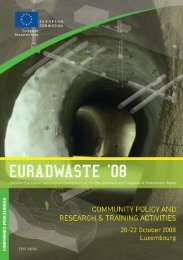Life Events - EU Bookshop - Europa
Life Events - EU Bookshop - Europa
Life Events - EU Bookshop - Europa
You also want an ePaper? Increase the reach of your titles
YUMPU automatically turns print PDFs into web optimized ePapers that Google loves.
••• 18<br />
and enabling diff erent options for the provision of core services. As a result,<br />
public agencies, third parties, intermediaries, and end-users – indeed, citizens<br />
themselves – could become engaged much more collaboratively in producing,<br />
combining, embedding, re-packaging and delivering a variety of core services.<br />
Th is is implicitly a more Gov 2.0 approach.<br />
Shift s towards Gov 2.0 are already underway: it could be even more fi rmly based<br />
on service provision via a service-oriented architecture. It is clear from the outline<br />
of the benefi ts that arise from the proposed new means of service delivery and the<br />
expectations of users that a move in this direction is inevitable. Not only do users<br />
expect such services to be developed but the services will also enable public agencies<br />
as well as third parties to create important added-value for society as whole.<br />
To enable this type of service delivery in the near future requires a clear<br />
commitment to put the key enablers in place and to agree on a clear common<br />
vision. Government plays an essential role in facilitating the creation of these<br />
prerequisite underlying elements and tackling the major obstacles.<br />
In 2010, governments are hard-pressed to make choices about the kinds of<br />
mechanisms that enable them to continue to provide access to high-quality<br />
and safe services that are cost-eff ective for both themselves and their users 7 . An<br />
adaptation of the Gov 2.0 life events model to government services can refl ect both<br />
the expectations of users, and resolve a number<br />
of the challenges that surround public service<br />
provision (for awareness of such challenges,<br />
see for example, the Ministerial Declaration on<br />
eGovernment (2009) 7 , and the Fift h Ministerial<br />
eGovernment Conference (2009) 8 and the<br />
European Commission Communication on<br />
Europe 2020 (2010) 9 ).<br />
7 Ministerial Declaration on eGovernment, 2009, http://www.egov2009.se/wp-content/uploads/Ministerial-<br />
Declaration-on-eGovernment.pdf<br />
8 Conference Proceedings, Fift h Ministerial eGovernment Conference, http://ec.europa.eu/information_society/<br />
activities/egovernment/conferences/past/malmo_2009/press/conference_proceedings.pdf 2009<br />
9 European Commission, Europe 2020, A strategy for smart, sustainable and inclusive growth, COM<br />
(2010) 2020 fi nal, http://europa.eu/press_room/pdf/complet_en_barroso___007_-_europe_2020_-_en_version.pdf
















